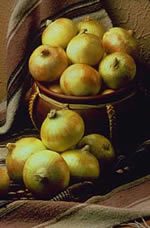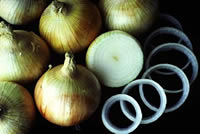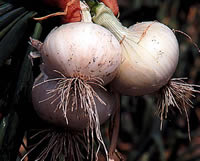|

Return to Gardening Columns Main Index
Delayed Onion Transplanting Techniques
by Jerry Parsons, Ph.D.
I wrote a column entitled “Onion Transplanting Time” http://plantanswers.com/garden_column/012602/012602.htm and originally published it in late January. The column stated that “onion transplants should be planted as soon as possible (in January or February) so that they can establish a large root system before optimum bulbing conditions occur”. At the beginning of the growing process, onions form green leaves or "tops"; the number and size of which ultimately determine the size of the onion bulb at maturity. Each onion leaf corresponds to a single ring; the bigger the leaf, the bigger the ring. After the tops are formed, the bulbing stage begins.
 Bulbing is dependent upon day length and temperature, not the size or age of plants. Therefore, successful onion production is dependent upon proper variety selection for day length in your growing area. As a general rule, long day onions do better in northern states (north of the 36th parallel) during the summers, while short day onions do better in states south of that line. Intermediate day onions will do well in many different areas, depending on the season. So a gardener should choose onions by the onion variety’s day length -- after determining which day lengths are appropriate for their area of the country.
Bulbing is dependent upon day length and temperature, not the size or age of plants. Therefore, successful onion production is dependent upon proper variety selection for day length in your growing area. As a general rule, long day onions do better in northern states (north of the 36th parallel) during the summers, while short day onions do better in states south of that line. Intermediate day onions will do well in many different areas, depending on the season. So a gardener should choose onions by the onion variety’s day length -- after determining which day lengths are appropriate for their area of the country.
In south and south central Texas, the good nurseries only sell the well-adapted, short-day onion types from the largest grower of onion transplants in the United States, Dixondale Farms in Carrizo Springs, Texas. (http://www.dixondalefarms.com/) Short day onions start making bulbs early in the year, when there are only 10-12 hours of daylight. They are planted primarily in the south during winter or early spring, and take about 110 days to mature. If planted in northern states in late spring, they'll mature in just 75 days, but will produce smaller bulbs. The short-day varieties are available December through early April.
What about those folks who “delay” transplanting until March rather than planting during the ideal time of January and February? If you fall into that category, you should consider using an intermediate day length onion variety. Intermediate day onions fall in the 12-14 hours of daylight category, which makes them the most widely adaptable of all our onion varieties. When planted late in a short-day length planting area, they'll mature in about 100 days. Depending on the early summer temperatures, you should have enough daylight hours to make nice-sized bulbs. All the intermediate day varieties which Dixondale Farms sell are exceptionally sweet. They include ‘Candy’, a yellow onion; ‘Red Candy Apple’, a red onion; and ‘SuperStar’, a white onion. All of these should be planted as soon as possible in March and no later than early April. The later you plant, the smaller the onion bulbs will be.
The onion transplants should be planted at least 4 inches apart and one-inch deep (knuckle deep) or until all roots are covered and the main crown is partially covered. For more information and drawings, see:
http://plantanswers.com/Resources/Vegetable/E-514_onions.pdf
For best results and maximum sized onion bulbs, certain procedures should be followed. Fertilization of onion transplants is vital to success. Texas A&M research findings indicate that onion growth and yield can be greatly enhanced by placing or banding phosphorus 2-3 inches below transplants at planting time. This phosphorus acts as a starter solution which invigorates the onion’s early growth.

Banding phosphorus, such as super phosphate (0-20-0), 2-3 inches below the plant involves making a trench or planting furrow 4 inches deep in the raised planting bed, distributing one-half cup (one-half pound) of super phosphate per 10 linear feet of row, covering the phosphate with 2 inches of soil, and planting transplants. Phosphorus will not burn and/or kill the transplants.
 Once established, the onions really need a constant source of nitrogen. It has been recommended that the plants should be fed EVERY two or three weeks with additional amounts of fertilizer such as ammonium sulfate (21-0-0) or 19-5-9 (any slow release granular fertilizer) as a sidedress application -- use one pint or one pound per 100 square feet (10' X 10') of planting area. BUT WHO REMEMBERS TO DO IT. With these late planted onions I am recommending that a cup of Osmocote Slow-release or the recently available multicote (18-6-12 with slow-release minor nutrients) fertilizer per 10 linear feet of row be placed or banded 2-3 inches below the plants mixed with the super phosphate application mentioned above. Then you will not have to remember to fertilize your onions every 2-3 weeks for the duration of the crop to obtain maximum growth. If you are planting in a container and/or not in rows, put six tablespoons of the slow release, long acting formulations such as multicote and Osmocote mentioned above a few inches beneath the onion transplants or mix into the potting mix being used. It is hard to use too much multicote and Osmocote.
Once established, the onions really need a constant source of nitrogen. It has been recommended that the plants should be fed EVERY two or three weeks with additional amounts of fertilizer such as ammonium sulfate (21-0-0) or 19-5-9 (any slow release granular fertilizer) as a sidedress application -- use one pint or one pound per 100 square feet (10' X 10') of planting area. BUT WHO REMEMBERS TO DO IT. With these late planted onions I am recommending that a cup of Osmocote Slow-release or the recently available multicote (18-6-12 with slow-release minor nutrients) fertilizer per 10 linear feet of row be placed or banded 2-3 inches below the plants mixed with the super phosphate application mentioned above. Then you will not have to remember to fertilize your onions every 2-3 weeks for the duration of the crop to obtain maximum growth. If you are planting in a container and/or not in rows, put six tablespoons of the slow release, long acting formulations such as multicote and Osmocote mentioned above a few inches beneath the onion transplants or mix into the potting mix being used. It is hard to use too much multicote and Osmocote.
 NOW is the time to act if you want to insure a crop of big “stinkers” this season but at this late date, use the onion varieties and fertilization techniques mentioned above.
NOW is the time to act if you want to insure a crop of big “stinkers” this season but at this late date, use the onion varieties and fertilization techniques mentioned above.
For more information about the famous Texas onion and its relationship to every other sweet onion in the world, see:
http://www.plantanswers.com/publications/onions/onionhis.html
|



